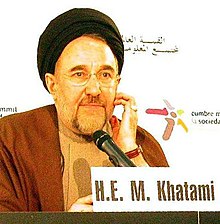Government of Mohammad Khatami (1997–2005)
| Sayyid Mohammad Khatami سيد محمد خاتمى |
|
|---|---|
 |
|
| President of Iran | |
|
In office 2 August 1997 – 3 August 2005 |
|
| Vice President |
Hassan Habibi Mohammad Reza Aref |
| Leader | Ali Khamenei |
| Preceded by | Akbar Hashemi Rafsanjani |
| Succeeded by | Mahmoud Ahmadinejad |
| Personal details | |
| Born |
14 October 1943 Ardakan, Iran |
| Nationality | Iranian |
| Political party | Association of Combatant Clerics |
| Spouse(s) | Zohreh Sadeghi (m. 1974) |
| Children | Leila Khatami (born 1975) Narges Khatami (born 1980) Emad Khatami (born 1988) |
| Residence | Tehran, Iran |
| Alma mater |
Isfahan University Tehran University |
| Religion | Usuli Twelver Shi'a Islam |
| Website | Mohammad Khatami |
The Government of Mohamamd Khatami was the 7th and 8th government of Iran after the Iranian Revolution. At that time, Mohammad Khatami was president.
Running on a reform agenda, Khatami was elected president on 23 May 1997 in what many have described as a remarkable election. Voter turnout was nearly 80%. Despite limited television airtime, most of which went to conservative Speaker of Parliament and favored candidate Ali Akbar Nateq-Nouri, Khatami received 70 percent of the vote. "Even in Qom, the center of theological training in Iran and a conservative stronghold, 70% of voters cast their ballots for Khatami." He was re-elected on June 8, 2001 for a second term and stepped down on 3 August 2005 after serving his maximum two consecutive terms according to the Islamic Republic's constitution.
Khatami supporters have been described as a "coalition of strange bedfellows, including traditional leftists, ... business leaders who wanted the state to open up the economy and allow more foreign investment" and "women and younger voters."
The day of his election, the 2nd of Khordad, 1376, in the Iranian calendar, is regarded as the starting date of "reforms" in Iran. His followers are therefore usually known as the "2nd of Khordad Movement".
Khatami is regarded as Iran's first reformist president, since the focus of his campaign was on the rule of law, democracy and the inclusion of all Iranians in the political decision-making process. However, his policies of reform led to repeated clashes with the hardline and conservative Islamists in the Iranian government, who control powerful governmental organizations like the Guardian Council, whose members are appointed by the Supreme Leader. Khatami lost most of those clashes, and by the end of his presidency many of his followers had grown disillusioned with him.
As President, according to the Iranian political system, Khatami was outranked by the Supreme Leader. Thus, Khatami had no legal authority over key state institutions: the armed forces, the police, the army, the revolutionary guards, the state radio and television, the prisons, etc. (See Politics of Iran).
...
Wikipedia
